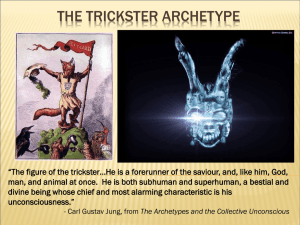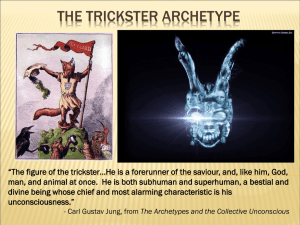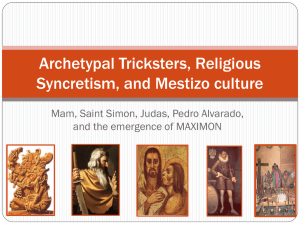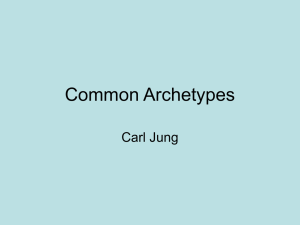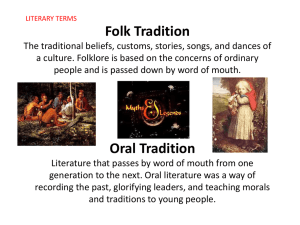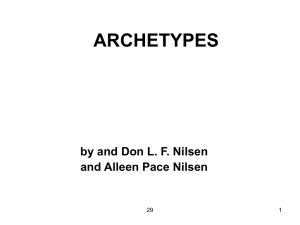The Trickster Archetype: Definition, Examples, and Modern Reverberations
advertisement
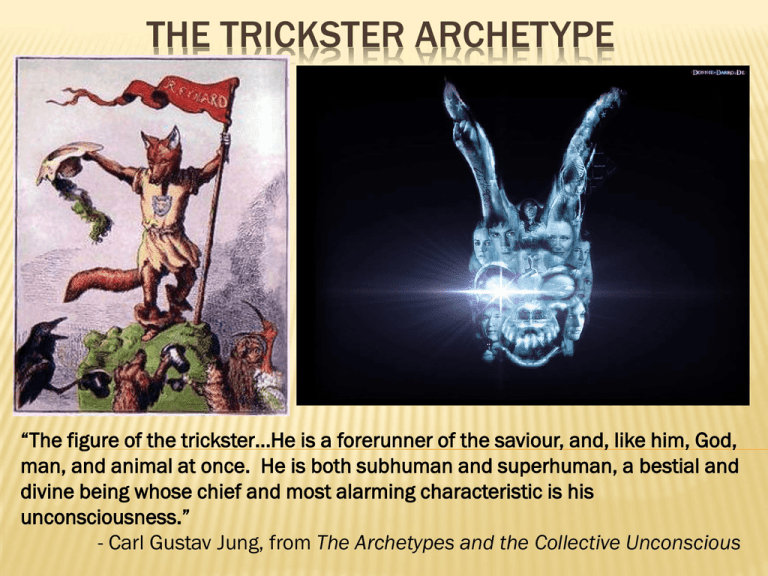
THE TRICKSTER ARCHETYPE “The figure of the trickster…He is a forerunner of the saviour, and, like him, God, man, and animal at once. He is both subhuman and superhuman, a bestial and divine being whose chief and most alarming characteristic is his unconsciousness.” - Carl Gustav Jung, from The Archetypes and the Collective Unconscious THE TRICKSTER ARCHETYPE Seeking to define the Trickster is a treacherous task. He is a slippery figure who shifts shape, challenging authority and disrupting order. The Trickster is a seer of limited sight- part human and part supernatural. His prophecies are often riddled with halftruths and lies, falsities that somehow point toward a higher truth. The Trickster possesses the keen ability to see these hidden meanings and uses these insights to transform himself or to act as a catalyst in the changing of others. THE TRICKSTER ARCHETYPE But the Trickster’s schemes or tricks can often be self-defeating and harmful to other individuals. Although he is partially divine and mortal, the Trickster is also sub-human. Due to his oracular insights and his subhuman state, he is often the alienated outsider. Functioning on the fringes of society, the Trickster works his strange medicine to challenge taboos and crumble the structures of civilization. The Outsider by Thomas Homer THE TRICKSTER ARCHETYPE Sometimes acting as a magician, the Trickster directly reshapes the surrounding world with inner magic. Continually weaving old into new. But the Trickster can often also act as a kind of holy fool – working behind a ridiculous façade to perform these strange changes unknown and unnoticed. THE TRICKSTER ARCHETYPE Though the Trickster resists typical classification, he is there forever blurring realities in order to reshape the world. If you try to follow his trail, like Carroll’s Alice down the rabbit hole, you may find yourself lost and bewildered. But the discoveries you make on your winding roads will make the journey worth the effort. THE TRICKSTER ARCHETYPE “In short, the trickster is a boundary crosser. Every group has its edge, its sense of in and out, and trickster is always there…He also attends the internal boundaries by which groups articulate their social life. We constantly distinguish – right and wrong, sacred and profane, clean and dirty, male and female, young and old, living and dead – and in every case trickster will cross the line and confuse the distinction. Trickster is the creative idiot, therefore, the wise fool, the gray-haired baby, the cross-dresser, the speaker of sacred profanities…Trickster is the mythic embodiment of ambiguity and ambivalence, doubleness and duplicity, contradiction and paradox” (Hyde 7). THE TRICKSTER ARCHETYPE “A curious combination of typical trickster motifs…[include] his fondness for sly jokes and malicious pranks, his powers as a shape-shifter, his dual nature, half animal, half divine, his exposure to all kinds of tortures, and – last but not least – his approximation to the figure of a saviour” (Jung 255). THE TRICKSTER ARCHETYPE The Trickster archetype connects with other various important archetypes and literary traditions. Due to his association with the bestial elements of life and the unconscious realms of creation, Trickster frequently frequents with the Shadow. In Trickster’s guise of the savior, the archetype aligns with the Christ figure and can serve as an inroad to the united Self. In his sub-human but somehow supernatural form, Trickster often plays a pivotal role in numerous animal fables as a miscreant hero. MULTI-CULTURAL EXAMPLES OF TRICKSTERS African American Folklore – The Hare French Folktales – The Fox Native American Mythology – The Crow and the Coyote Western African Folklore – Anansi the Spider East Indian/Asian Myths – The Monkey Greek/Roman Mythology – Hermes/Mercury Roman Mythology - Janus Norse mythology – Loki When exploring possible literary representations of the Trickster, keep an eye out for characters who use their wits instead of brute strength to survive and/or live on the edges of society and possess oracular vision. These characters will usually bring about some form of significant transformation/reformation within themselves, within others, or cause some form of change in their surroundings. These transformations that the Trickster catalyzes usually will involve some form of inversion of societal norms or the blurring of cultural/situational/temporal boundaries. The Trickster is also routinely a salvific figure capable of bringing redemption through his or her unusual methodologies. LITERARY APPLICATION – THE TRICKSTER In T. H. White’s classic The Once and Future King, Merlin is re-imagined as a slightly bumbling, quirky, but nonetheless magical helper to young Arthur. Though he does traditionally fulfill the role of the guide in King Arthur’s heroic journeys, within White’s novel he also serves as a Trickster figure. Through his various physical transformations of Wart into the various creatures of field, stream, and sky, through the more subtle and important alchemy he performs on the budding character of his charge, Merlin proves himself a suitable Trickster representative. Aside from his tricksterish career as a magician, Merlin even travels backward through time. He, therefore, blurs linear temporal boundaries and can act as an oracle, “Now ordinary people are born forwards in Time…But I unfortunately was born at the wrong end of time, and I have to live backwards…Some people call it having second sight” (White 35). MODERN REVERBERATIONS OF THE TRICKSTER Not quite as ubiquitous as the Shadow, the Trickster figure still rears its head frequently in our modern culture - bringing strange changes in his wake. CHARLIE CHAPLIN’S THE TRAMP The Tramp is a bumbling but goodnatured character created and portrayed by Charlie Chaplin, a wellknown silent movie star. This vagrant character strains to behave and radiate the dignity of a gentleman, but he instead fouls up unintentionally. The Tramp habitually uses his cunning to reach his goals and to escape looming authority figures who are intolerant of his antics. Chaplin, as the Tramp, also continually uses familiar aspects of his surroundings in unfamiliar and novel ways. Whether using wooden chairs as armor or potatoes as synchronized dancing feet, the Tramp takes the traditional and utilizes it untraditionally to create something new. BRE’R RABBIT AND BUGS BUNNY Bre’r Rabbit is a reccurring character from African American folktales who uses his wits and trickery to outsmart Bre’r Fox and Bre’r Bear. Originally a Cherokee Trickster, Bre’r Rabbit was appropriated into the African American oral tradition. A more contemporary rabbit, Bugs Bunny, also continually eludes his tormentors through foolish deceptions, myriad disguises, and verbal trickery. Both of these “rascally rabbits” highly exemplify the wily nature of the Trickster. THE ROADRUNNER AND WILE E. COYOTE Both Wile E. Coyote and the Roadrunner could be considered Trickster figures. Whether constructing or evading various elaborate traps and tricks, both the Roadrunner and the Coyote are forever locked in a tricksterish dance – each striving to use his wits to finally emerge victorious. Though he struggles to use his cunning to defeat the Roadrunner, Wile E. Coyote is continually foiled by fate and his opponent’s speed. Both figures use their wits in a continual loop of trickery. THE CHESHIRE CAT FROM ALICE’S ADVENTURE IN WONDERLAND A source of sporadic and frustrating “guidance” for Alice on her wayward way through Wonderland, the Cheshire Cat is a good example of a not-so-helpful trickster guide. Not truly malicious in his intent, the Cheshire Cat does want to truly hurt or hinder Alice – just merely make the situation as confusing and interesting as possible with his special brand of “assistance”. http://www.youtube.com/watch?v=lUnqbBgYZmI BART SIMPSON AS A TRICKSTER Bart, from The Simpsons, is an untraditional Trickster. Through his various pranks, schemes, and adventures, this rabble rouser continually causes his own demise and often accidentally brings about positive change in the lives of others (usually as an unintended by-product of a scoundrel’s scheme). Behind the thin veil of existential apathy and disruption, Bart possesses true integrity despite his extreme selfishness and delusions of grandeur. FRANK THE RABBIT FROM DONNIE DARKO In the existential teenage drama Donnie Darko, a giant rabbit from the recent future named Frank appears to the protagonist with advice on how to avert the impending destruction of the town. With Frank’s help, Donnie is able to perform a sacrificial action that saves the lives of those he loves. But Frank is not a typical savior; his cryptic advice is eerie and confusing and our hero is unsure if Frank’s visits are merely a troubling side effect of his antidepressant medication. For these reasons, Frank is a haunting Trickster figure stepping in to bring about change. GUIDO FROM LIFE IS BEAUTIFUL Instead of telling his son the ghastly truth about the Jewish Holocaust, the tricksterish Guido instead creates a fantasy world where the horrors of the death camp are transformed into the various trials and tribulations of a highly elaborate game (with the imagined grand-prize of full-sized tank). Simultaneously struggling to keep his family safe while maintaining this façade for the benefit of his son, Guido somehow manages to walk his winding, treachorous path. http://www.youtube.com/watch?v=0Y9aKqawdUQ MAJOR RESOURCES Hyde, Lewis. Trickster Makes This World: Mischief, Myth, and Art. New York: North Point Press, 1998. Print. Jung, C. G. The Archetypes and the Collective Unconscious. 2nd ed. New York: Princeton University Press, 1959. Print. White, T.H. The Once and Future King. New York: Berkeley Publishing Group, 1939. Print.


